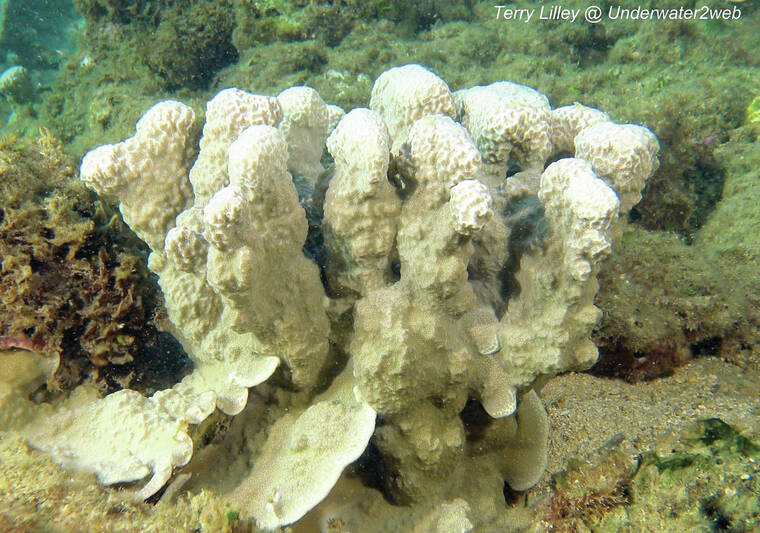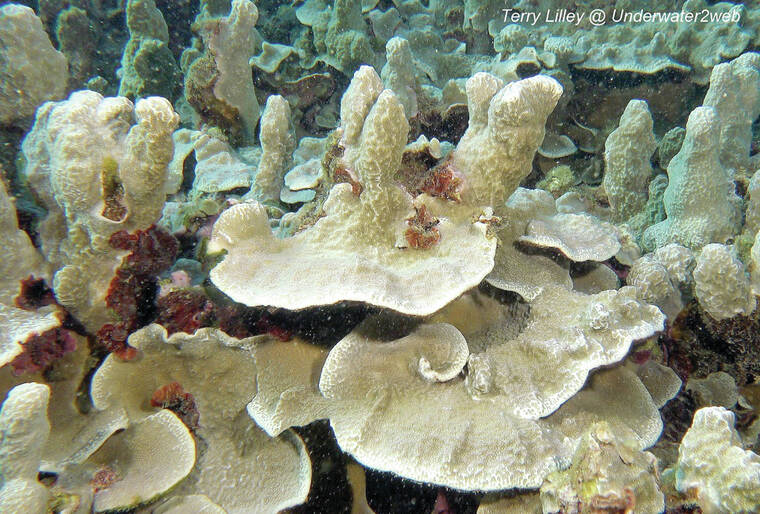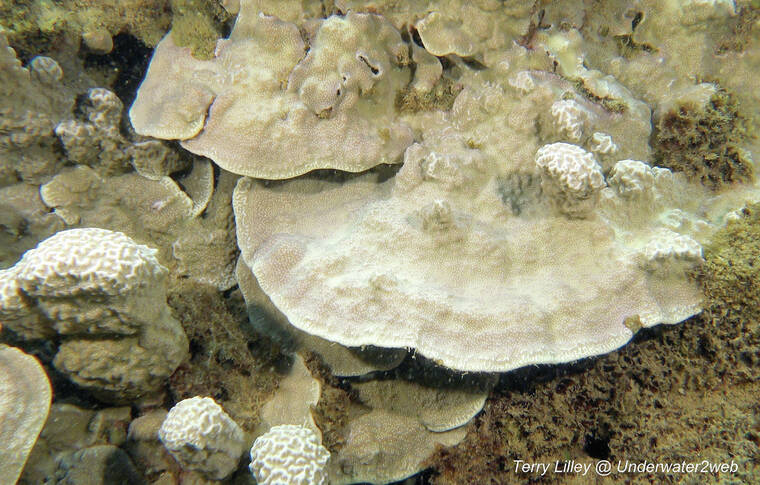Yes, this is an animal, even though it looks just like a concrete patio deck with flower pots on top growing weird plants in them! Very few people in Hawai‘i have ever seen this coral even though there is a huge colony of it growing right out in front of the former St. Regis Hotel in Kaua‘i. The problem is people do not recognize it as coral, and it is so rare here in Hawai‘i that I have only seen it grow at three locations in Kaua‘i, a small amount on O‘ahu and Molokini Islet, one side of Moloka‘i and a few bays along the Kona Coast of Hawai‘i Island.
Yes, this is an animal, even though it looks just like a concrete patio deck with flower pots on top growing weird plants in them! Very few people in Hawai‘i have ever seen this coral even though there is a huge colony of it growing right out in front of the former St. Regis Hotel in Kaua‘i. The problem is people do not recognize it as coral, and it is so rare here in Hawai‘i that I have only seen it grow at three locations in Kaua‘i, a small amount on O‘ahu and Molokini Islet, one side of Moloka‘i and a few bays along the Kona Coast of Hawai‘i Island.
This very-crazy-looking coral looks totally different from one reef to the next, and from one island to the other. Even most divers and scientists won’t know it is the same coral species, but DNA tests need to be done to see if it is a different species. DNA tests could determine that the plate coral colony at Princeville Kaua‘i could be its own species and therefore extremely rare, as it almost died twice in the last 10 years! It was covered in mud during the 2018 Hanalei flood and I could not find any left alive six months later. Two days ago I drove to the site and there is so much that has grown back, it looks like some contractor poured all their excess concrete out on the reef and covered an entire 50-meter square section of the reef!
We already know from past DNA studies that were done by the University of Hawai‘i and U.S. Geological Survey that some Kaua‘i corals have unique and different DNA than any other Hawaiian Islands except Ni‘ihau! This was stunning information, because if the coral dies on Kaua‘i it may not be replaceable and 4 million years of evolution would be lost! This is why day-by-day coral-reef monitoring is so important. We don’t want man-made “super corals,” but we do want to study and protect the corals that are “nature made” so they can last another million years! Corals can and are adapting to climate change. If we just study them and help them along by cleaning up their habitat they will thrive.
Just identifying the hard, stony plate coral is difficult because the colonies can grow in a small patch or grow together to form an entire reef cover that looks like a concrete parking lot. The coral is always a gray color, which is unusual because most coral species vary in color depending on the type of algae the coral grows in their soft tissue. The plate coral grows flat on the reef and looks like layers of China dinner plates stacked on the edge of a reef in calm water. This same coral can also look like a high-rise city with tall concrete buildings growing upwards on concrete streets. In super-calm water, the tall pillars grow better, and in areas with more surf and currents the dinner-plate form grows best. In some areas, the dinner-plate variety grows on the flat reef and a single tall pillar will grow upwards right out of the center of the plate.
Like most stony, hard, reef-building corals, the plate coral needs the sunshine to grow because the live, soft coral tissue has algae growing inside it, and the coral polyps feed on the sugars the algae produces as a byproduct of photosynthesis. This causes these corals to cover a reef in order to absorb the most sunlight they can, and they can’t live very deep, as the sea filters out the sunlight.
These corals grow in the most-exposed area on the entire island to pollution. Runoff from improper development and farming can cover the coral in silt and farm chemicals. Changing the course of a waterway can drown the coral in freshwater or starve the coral of nutrients. Kaua‘i corals grow best on the edge of the fresh and saltwater, so altering a waterway can kill an entire reef!
You can see the plate coral in its many forms up on my Facebook page just under my name and also up on my underwater educational web page at underwater2web.com.
•••
Terry Lilley is a marine biologist living in Hanalei and co-founder of Reef Guardians Hawai‘i, a nonprofit on a mission to provide education and resources to protect the coral reef. To donate to Reef Guardians Hawai‘i go to www.reefguardianshawaii.org.




